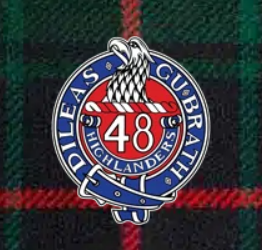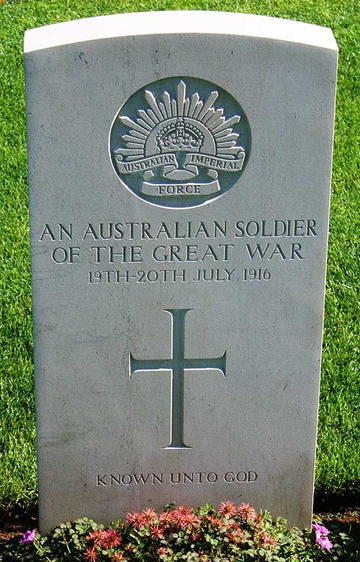
Arthur Mossop JAMES
Eyes grey, Hair light, Complexion fair
Arthur Mossop James – A Brick Wall Search for His Identification
Can you help to identify Arthur?
Arthur’s body was never found after the battle, though his identification disc was returned by the Germans. There is a chance he might be identified, but we need help to find DNA donors.
A mass grave was found in 2008 of 250 bodies buried by the Germans after the battle. Many are from the 30th Battalion, like Arthur. As of 2024, identification via DNA has been made for 180 of the soldiers and for many of the 70 remaining unidentified soldiers some identifications are highly likely.
Arthur came by himself to Australia and did not have any family in Australia that we know of, but it is clear that he had strong ties to his mother Sarah (nee James) and family back in Chelsea, London, UK, although his father is unknown.
If you know anything of Arthur’s contacts or his relatives in England, we would like to hear from you. See the DNA box at the end of the story summarising what we do know about his family.
Arthur’s Early Life
Arthur Mossop James was born in the June quarter of 1888 in Chelsea, England, shortly before his mother Sarah Susan James married Albert James Ashton. They were wed at the St Clements Inn parish church on 15 July 1888.
Arthur, Sarah and Albert were living at 13 Vere Street. This was likely to have been a public house, as Albert was a public house manager and the Vere Street address was occupied by a publican in the 1891 census. Other census records for Albert show occupations and addresses related to public houses. Accordingly, Arthur would have grown up being familiar with the pubs and densely populated areas of inner-city London.
Arthur attended the Cook’s Ground Board School in Chelsea.
As was typical of thousands of UK-born young men, Arthur left his family in England for employment and adventure.
Canada appears to have been his first stop. His Australian enlistment papers state that he served in the “48th Canadian Royal Scots”. We are unsure exactly which unit this refers to, the Toronto-based 48th Highlanders of Canada or the Montreal-based 5th Royal Scots of Canada.
Arthur did have a family connection in Toronto, so it seems likely that he would have headed there. His step-grandmother Helen Ashton had emigrated to Toronto in about 1906 with Albert’s younger sister Alice Ralph (nee Ashton) and Alice’s family.
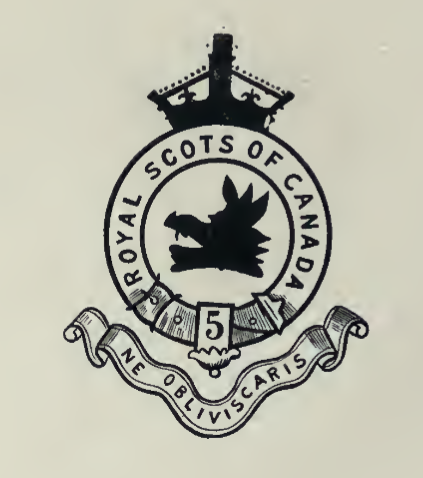
His service with the Canadian Royal Scots was brief, just two months, and he resigned because he was leaving the area.
We believe Australia was his next stop. There is a record for an A. James, aged 24 and born in London, who arrived in Sydney from Vancouver on 28th September 1912. If this is in fact “our Arthur”, he had signed on as a member of the crew, working as a general servant.
There are notes written by his mother after the War that by 1912 the 24 year-old Arthur was living in Australia. In 1915 he was working as a despatch clerk and living at “Alicia”, Railway Street, Epping, New South Wales.
He had some connection with a Mr. Coleman of Epping, NSW as he entrusted him with £50 to be given to his mother in the event of his death. We know nothing more of Mr. Coleman.
Off to War
Arthur felt the call to war and he enlisted in mid-July 1915 in Sydney. He was allocated to the newly formed 30th Battalion as a private in C Company. Training commenced in the Liverpool camp, but in September they were moved to the Royal Agricultural Show Grounds in Moore Park, Sydney. There were numerous reports of their activities in the papers.
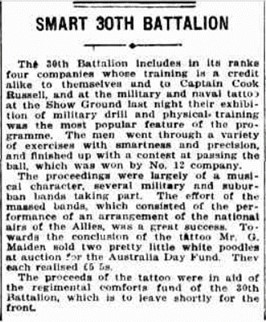
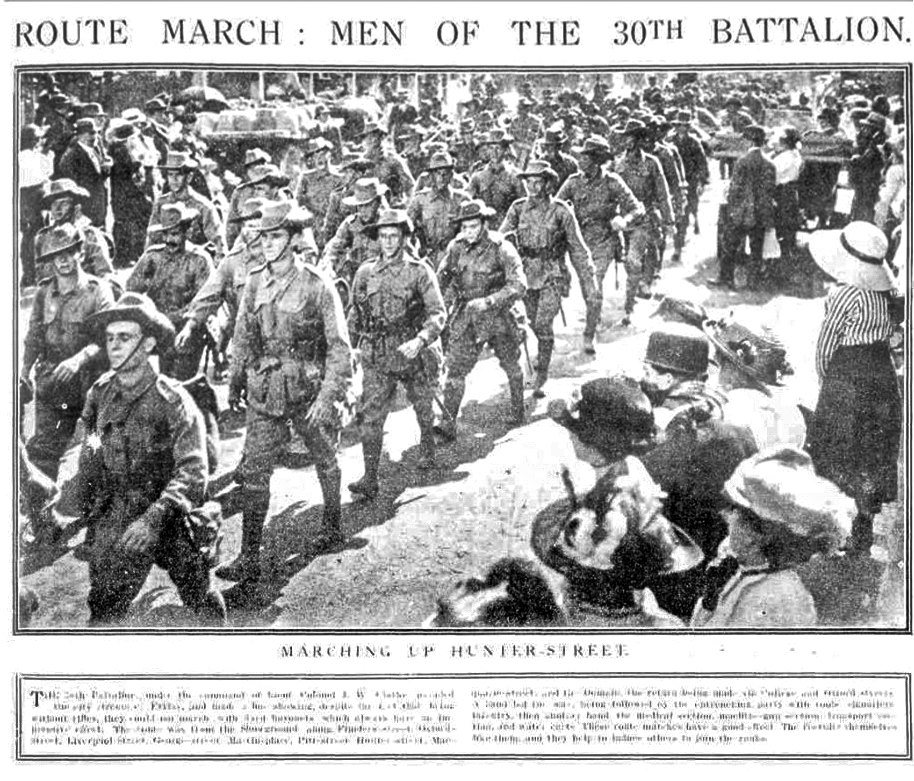
Arthur was granted a short period of pre-embarkation leave on 8 September and his Battalion left Australia aboard HMAT A72 Beltana on 8 November 1915. Their trip was uneventful and they disembarked in Egypt on 11 December.
The 30th were first encamped in Heliopolis. They also were at Ferry Post and Tel-el-Kebir, handling defensive duties along the Suez Canal along with continued training. There were the usual soldier’s complaints of the heat, water supplies and flies. They were proud to be inspected by H.R.H. Prince of Wales in March.
Arthur suffered a couple of short stints in hospital, firstly with a sprained ankle, then diarrhoea and finally with a wounded arm as a result of an accident whilst training in bomb throwing. His final discharge from hospital was in early June which was just before the 30th headed for Europe and the Western Front.
Arthur left Egypt with his Battalion on 16 June 1916 and arrived in Marseilles on 23 June. After landing, there was a 60+ hour train ride to Hazebrouck, 30 kilometres from Fleurbaix. They arrived on 29 June and then encamped in Morbecque.
Private F.R. Sharp wrote home:
“From the time we left Marseilles until we reached our destination was nothing but one long stretch of farms and the scenery was magnificent.” “France is a country worth fighting for.”
Training now included the use of gas masks and in the background they would have heard the heavy artillery from the front lines.
On 8 July they were headed to the front lines, first to Estaires, 20 kilometres and the next day 11 kilometres to Erquinghem, where they were billeted at Jesus Farm. They got their first ‘taste’ of being in the front lines at 9 PM on 10 July.
The Battle of Fromelles
The 30th Battalion's first major battle was at Fromelles on 19 July 1916. It was tasked with supporting the 31st and 32nd Battalions in the front line by digging trenches and, for Arthur’s C company, carrying supplies and ammunition.
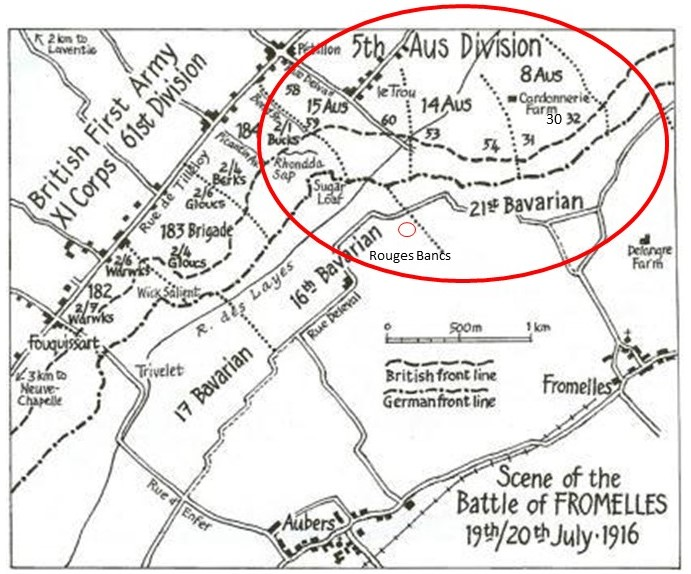
The 32nd’s charge over the parapet began at 5:53 PM and the 31st’s at 5:58 PM. There were machine guns emplacements to their left and directly ahead at Delrangre Farm and heavy artillery fire in No-Man’s-Land.
The initial assaults were successful and by 6:30 PM the Aussies were in control of the German’s 1st line system, which was described as:
“practically a ditch with from 1 to 2 feet of mud and slush at the bottom”.
While their role was to be in support, commanders on scene made the decision to use the 30th as much-needed reinforcements. A necessary act, but it had consequences as it interfered with the planned flow of supplies.
By 8.30 PM the Australian’s left flank had come under heavy bombardment with high explosives and shrapnel. Return bombardment support was provided and the troops were told that “the trenches were to be held at all costs”.
When called at 10:10 PM to ‘formally’ provide fighting support, Lieutenant-Colonel Clark of the 30th reported:
“All my men who have gone forward with ammunition have not returned. I have not even one section left.”
Fighting continued through the night. At 4:00 AM the Germans began an attack from the Australian’s left flank.
Up ahead, the Australians made a further charge at the main German line, but they were low on grenades, under machine gun fire from behind from the emplacement at Delangre Farm and they were so far advanced that they were getting shelled by both sides.
We can't be sure exactly where Arthur was in the battle or when he was killed, but researchers have concluded that it had to have been on the eastern side of the battle and in front of Delangre Farm.
By 10:00 AM on the 20th, the Germans had repelled the Australian attack and the 30th Battalion were pulled out of the trenches. Initial figures of the impact of the battle on the 30th were 54 killed, 68 missing and 230 wounded.
One of the Missing
Arthur was reported as one of the many missing after the battle.
Arthur’s mother Sarah was advised he was missing in August and in November a letter was written on her behalf to the Red Cross seeking information about her son. The Red Cross initiated enquiries and eventually obtained two statements from fellow 30th Battalion soldiers.
The first was from a Pte 741 Frank W. Raysmith, who stated that Arthur was wounded in the battle and evacuated to England. However, this appears to have been a case of mistaken identity and confusion with another Pte A. James, namely Pte 691 Albert Hampton James, who survived the battle and eventually returned home to Australia. See Albert James' story which is also told on this website.
The second witness statement is more likely to relate to Arthur. Fellow-Englishman, Private 759 Fred Scholes:
stated that he had been told “by Pte. C. R. Daws of C Co., 9 Pl., that he was with A. James when he was killed. He was shot in the stomach. It was on the 19th July at Fromelles between the German 1st and 2nd lines.”
Private Daws is probably English-born Pte 145 Clarence Roy Dawson of Newcastle, New South Wales.
It was not until about nine months later that Arthur’s death was officially confirmed. His name was one of those that appeared on what became known as the German Death list and his identity disc was later returned to British authorities.

Sarah received her son’s identification disc in 1919 and later received his war service medals. It seems, that she never received the memorial plaque as she had changed address and the file is noted in 1924 as ‘plaque returned from London to scrap’.
While Arthur had left his mother and stepfather behind in London a number of years earlier, they were not forgotten. The will he made when he joined the Army left all he had to his mother.
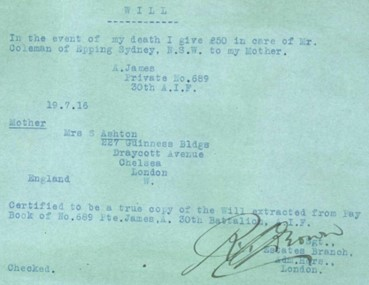
Arthur’s name is commemorated on three continents:
- In France, panel 2, V.C. Corner, Australian Cemetery and Memorial, Fromelles;
- In Australia, panel 117, Australian War Memorial, Canberra, ACT; and
- In Scotland, Roll of Honour, Scottish National War Memorial, Edinburgh.
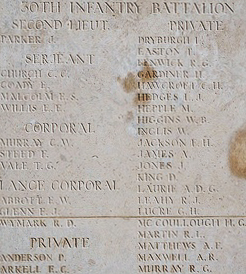
A Brick Wall Search for Arthur’s DNA?
Many of the 250 bodies buried by the Germans in the mass grave after the battle are from the 30th Battalion, like Arthur. His ID tag was recovered by the Germans and he was on the German Death list.
As of 2024, 180 of the 250 bodies have been identified via DNA from family members. Some identifications are highly likely for the remaining soldiers, but Arthur’s family history presents a significant challenge.
Male Donors - unlikely
Arthur did not marry or have any children.
While it is not unlikely that his father was Albert Ashton, there are no records to confirm this and Albert and Sarah had no other surviving children, so there is no potential donor to trace. Further, Albert was also an illegitimate child, having been born to 17 year old Helen Jane Ashton in 1863 in Canterbury, Kent, so even Albert’s male lineage is uncertain.
Arthur’s middle name is Mossop. Is this a possible clue to his paternity?
It was a common naming convention to include the natural father’s surname in the case of an illegitimate child, so Arthur’s father could be from the Mossop family. A census of the time showed there was a Mossop family living in the same neighborhood. The Mossops were a well to do Lincolnshire family who had moved to London.
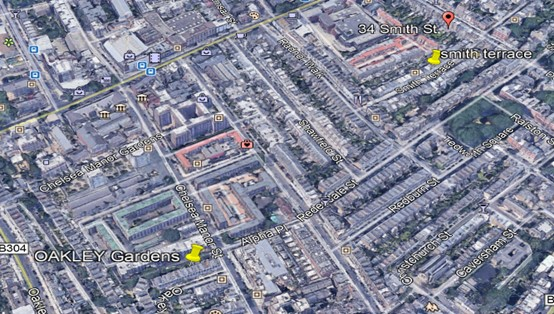
Female Donors – maybe, but highly complicated
Extensive research by Carol Wordingham has had to go back to the mid-1700’s to find a family line where there may be prospective female DNA donors.
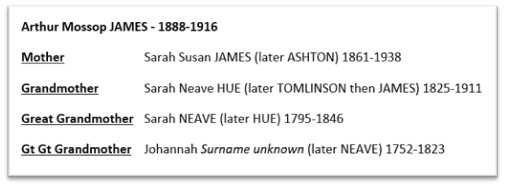
Arthur was Sarah and Albert’s only surviving child.
Sarah had a sister, but she never married, so no potential donors from this generation.
His grandmother had one daughter who then had one daughter, but she never married.
His great grandmother had one surviving sister, Hannah, who was born in 1786. Her descendants are a possible link.
The maiden name of his great-great grandmother is not known, so no links have been found yet that can be followed.
There are extensive details from this research which can be discussed with anyone who might be able to help.
URGENT. Can you help?
All DNA (Mt and Y) samples are still sought for family connections to
| Soldier | Arthur Mossop JAMES (illegitimate) 1888-1916 |
| Parents | Sarah Susan JAMES 1861-1938, Chelsea UK and [Possible] Unknown MOSSOP, Chelsea and Lincolnshire |
| Siblings | No siblings known |
| Grandparents | |||
| Paternal | Unknown | ||
| Maternal | Henry JAMES and Sarah Neave HUE |
Note. Was father a Mossop? There was a Mossop family living locally. Stepfather Albert James Ashton married Sarah when Arthur was about 3 months old.
Seeking DNA Donors

Contacts
(Contact: carla@fromelles.info or geoffrey@fromelles.info).
(Contact: army.uwc@defence.gov.au or phone 1800 019 090).
Donations
If you are able, please contribute to the upkeep of this resource.
(Contact: bill@fromelles.info ).
